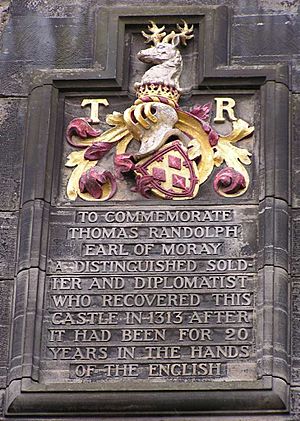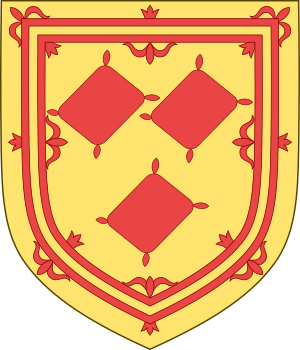Thomas Randolph, 1st Earl of Moray facts for kids
Quick facts for kids
Thomas Randolph
|
|
|---|---|
| Earl of Moray | |

Inscription on Edinburgh Castle
|
|
| Born | c. 1285 |
| Died | 20 July 1332 Musselburgh, East Lothian, Scotland |
| Spouse(s) | Isabel Stewart of Bonkyll |
| Issue | Thomas, 2nd Earl of Moray John, 3rd Earl of Moray Agnes Randolph Isobel Randolph |
| Father | Sir Thomas Randolph |
| Mother | Martha of Kilconquhar |
Thomas Randolph, Earl of Moray (born around 1285, died 20 July 1332) was an important Scottish soldier and diplomat. He played a key role in the Wars of Scottish Independence. Later, he even served as the ruler of Scotland for a short time. Thomas was the nephew of Robert the Bruce, a famous Scottish king. King Robert made him the first earl of Moray. Thomas is remembered for bravely capturing Edinburgh Castle from the English. He also signed the Declaration of Arbroath, a letter that declared Scotland's independence.
Contents
Who was Thomas Randolph's family?
Thomas was the son of another man named Thomas, who was a high-ranking official in Scotland. His mother was Martha of Kilconquhar. She was the older half-sister of Robert the Bruce. This means Thomas was King Robert's nephew.
Historians believe Thomas was born around 1285. His grandmother was born in the 1250s, so it's unlikely he was born much earlier.
Thomas Randolph's Role in the War of Independence
Thomas Randolph supported his uncle, Robert the Bruce, when he tried to become king in 1306. Thomas was likely made a knight by the king around this time.
Captured by the English
After a Scottish defeat at the Battle of Methven, the English captured Thomas. He was held by English lords. During this time, he joined the English side. However, in 1307, Sir James Douglas captured Thomas. Douglas convinced him to rejoin the Scottish cause.
When the English king, Edward II of England, heard about Thomas's change of loyalty, he took away all of Thomas's lands.
Becoming the Earl of Moray
In 1312, King Robert I made Thomas the Earl of Moray. This gave him control over a large area in northern Scotland. He also became the lord of the Isle of Man. Thomas became one of King Robert's most trusted leaders. He often went with the king on his military campaigns.
Capturing Edinburgh Castle
Thomas's most famous achievement was on March 14, 1314. He led a daring attack on Edinburgh Castle. This castle was one of the few in Scotland still held by the English. It sat on a very steep rock, making it seem impossible to capture.
One of Thomas's men, William Francis, knew a secret path up the rock. Thomas used this path to reach the castle. His brave attack successfully took the castle back for the Scots.
Thomas at the Battle of Bannockburn
Thomas Randolph played a very important part in the Scottish victory at the Battle of Bannockburn. He commanded one of the main groups of Scottish soldiers, called schiltrons. These were tight formations of spearmen.
On the first day of the battle, English cavalry tried to go around the Scottish army. Thomas led his men to block them. His schiltron formed a circle. The English attacked from all sides but could not break through the Scottish spears. They lost many men and had to retreat. This area became known as Randolph's Field. The next day, Thomas commanded the center of the Scottish army.
Thomas Randolph in Ireland
In 1315, Thomas Randolph went with Edward Bruce, the king's brother, to Ireland. They invaded Ireland to fight against the English settlers there. Thomas was one of the main leaders in this war. He returned to Scotland twice to get more soldiers and to ask King Robert to come to Ireland himself.
Raids and Battles on the Border
Thomas Randolph and Sir James Douglas often worked together. They were known for their brave actions.
Taking Berwick and Raiding England
In 1318, they captured the town of Berwick by climbing its walls. With help from a local citizen, they soon took control of the castle. The next spring, they raided northern England. They went as far as York, hoping to capture the English queen.
They defeated an English army led by the Archbishop of York. This fight was called the Battle of Myton, or "Chapter of Myton," because many churchmen were killed. Later that year, the two Scottish nobles raided England again. Eventually, the English king signed a two-year truce. In 1322, Thomas also helped Douglas in the Battle of Old Byland.
Thomas Randolph's Diplomatic Work
Thomas Randolph was also a skilled diplomat. His name is listed right after King Robert's on the 1320 Declaration of Arbroath. This important letter was sent to Pope John XXII. It asked the Pope to recognize Scotland as an independent country.
Meeting the Pope
In 1323, Thomas helped negotiate a thirteen-year truce between Scotland and England. Later, in 1324, he traveled to meet the Pope in person in Avignon. At this meeting, Thomas successfully convinced the Pope to recognize Robert as the King of Scots. This was a huge success for Scotland. The next year, the Pope wrote to Thomas, praising his efforts for peace.
Treaty with France
In 1325, Thomas was sent to France. His mission was to convince King Charles IV to sign the Treaty of Corbeil. This treaty renewed the Franco-Scottish alliance, a long-standing friendship between Scotland and France. Thomas succeeded in this task.
Achieving Scottish Independence
After returning to Scotland, Thomas played a leading role in the Battle of Stanhope Park against the English. The English suffered a big defeat. This forced them to sign the Treaty of Edinburgh–Northampton. This treaty finally recognized Scotland's independence.
Thomas Randolph as Regent
In King Robert's last years, Thomas was a constant companion. He also looked after the young prince, David. Before he died, King Robert decided that Thomas would be the regent for David. David was only five years old when he became king.
Thomas did a good job as regent, ruling fairly and wisely. However, he died three years later, on July 20, 1332, in Musselburgh. He was on his way to stop an invasion by Edward Balliol and his supporters. At the time, some said he was poisoned by the English. But modern historians think he likely died from a kidney stone. Donald, Earl of Mar took over as regent after him.
The poet John Barbour wrote a description of Thomas Randolph. Barbour likely knew Thomas personally. He described him as:
- Not too tall, and well-built.
- Having a broad, pleasant, and fair face.
- Polite and confident.
- Loving loyalty above all else.
- Always fighting against lies, betrayal, and bad deeds.
- Valuing honor and generosity.
- Always trying to do what was right.
- Caring and loving in company.
- Always loving good knights.
- Full of good spirits and virtues.
Thomas Randolph's Marriage and Family
Thomas married Isabel, the only daughter of John Stewart of Bonkyll. John Stewart was killed at the Battle of Falkirk. Thomas and Isabel had two sons and two daughters:
- Thomas, 2nd Earl of Moray
- John, 3rd Earl of Moray
- Agnes Randolph, who married Patrick, Earl of Dunbar. They had no children.
- Isabel (or Geilis) Randolph, who married Sir Patrick Dunbar. They had several children, including George, Earl of Dunbar and John, Earl of Moray. Isabel's children later inherited the title Earl of March.


